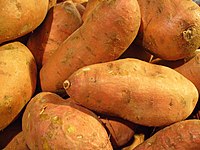
Photo from wikipedia
The control of carbon allocation, storage and usage is critical for plant growth and development and is exploited for both crop food production and CO2 capture. Potato tubers are natural… Click to show full abstract
The control of carbon allocation, storage and usage is critical for plant growth and development and is exploited for both crop food production and CO2 capture. Potato tubers are natural carbon reserves in the form of starch that have evolved to allow propagation and survival over winter. They form from stolons, below ground, where they are protected from adverse environmental conditions and animal foraging. We show that BRANCHED1b (BRC1b) acts as a tuberization repressor in aerial axillary buds, which prevents buds from competing in sink strength with stolons. BRC1b loss of function leads to ectopic production of aerial tubers and reduced underground tuberization. In aerial axillary buds, BRC1b promotes dormancy, abscisic acid responses and a reduced number of plasmodesmata. This limits sucrose accumulation and access of the tuberigen protein SP6A. BRC1b also directly interacts with SP6A and blocks its tuber-inducing activity in aerial nodes. Altogether, these actions help promote tuberization underground.
Journal Title: Nature plants
Year Published: 2022
Link to full text (if available)
Share on Social Media: Sign Up to like & get
recommendations!